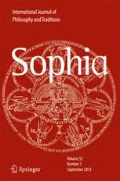Abstract
In this discussion, we ponder the discourse about the ‘body of the Divine’ in the Indian tradition. Beginning with the Vedas, we survey the major eras and thinkers of that tradition, considering various notions of the Supreme Divine Being it produced. For each, we ask: is the Divine embodied? If so, then in what way? What is the nature of the body of the Divine, and what is its relationship to human bodies? What is the value of the body of the Divine to the spiritual aspirant? We consider, where relevant, which views are pantheistic and which might be considered panentheistic. Panentheism is connected with discourse on the world as the body of God. It has origins in medieval Christian theology with anticipatory traces in Plato’s Timeaus. Under pantheism, were the world to end—were it to collapse or disappear irreversibly, perhaps, into a huge black hole—then God would disintegrate without a remainder as well; for in this view the Divine Spirit is the universe. The same is not true under panentheism which posits a more complex relationship between the Divine and the world. According to panentheism, God pervades the world—God is in the world—and at the same time, God sustains the world—the world is in God. This allows that God be greater than, transcendent of and independent of the world. In our conclusion we remark on how the views we have surveyed link to, resonate with, or dis-compare with the current—should one say revivified—interest in intellectual quarters with panentheism.
Similar content being viewed by others
Notes
See Purushottama Bilimoria, ‘Karma’s Suffering,’ Indian Ethics vol. I, eds. Purushottama Bilimoria, Joseph Prabhu and Renuka Sharma, Hampshire: Ashgate Publishing Limited, 2007; and B. K. Matilal, ‘A Note on Śaṃkara’s Theodicy,’ Journal of Indian Philosophy 20.4 (1992): 363–376.
Śrī Śaṅkarācārya, Brahma-Sūtra-Bhāṣya, Swāmī Gambhīrānanda trans., Calcutta: Advaita Ashrama, 2000, p. 613.
Swami Madhavananda trans., The Bṛhadāraṇyaka Upaniṣad with the Commentary of Śaṅkarācārya, Calcutta: Advaita Ashrama, 1997, p. 542.
Śaṅkarācārya, Brahma-Sūtra-Bhāṣya p. 612.
Gambhīrānanda, Swāmī trans. Eight Upaniṣads with the Commentary of Śaṅkarācārya. Vol. I. Calcutta: Advaita Ashrama, 2001, p. 176.
Shankara holds that Brahman is only described as embodied ‘for the sake of meditation’ (BSB 3.2.12). Meditation commonly involves an object on which the practitioner focuses awareness. Though Brahman is not really embodied, Shankara would explain this illusory notion is nonetheless useful to the practitioner as certain stages of his or her practice.
Umesh Mishra, Conception of Matter According to Nyāya-Vaiśeṣika, Allahabad, 1936; see also Nyāya-Vaiśeṣika, Encyclopedia of Indian Philosophies vol. II, ed. Karl H. Potter, Delhi: Motilal Banarsidass, 2003, pp. 100–02.
Phanibhūsana discusses this in his elucidation to Vātsyāyana. See Debiprasad Chattopadhyaya and Mrinalkanti Gangopadhyaya trans., Gautama’s Nyāya-sūtra and Vātsyāyana’s Bhāṣya with Phanibhūsana’s Tarkavāgīsa, Calcutta: Indian Studies Past & Present, 1975, p. 18. Daya Krishna raises the question of why Īśvara was thought to be included under ātman in the Nyāya-sūtra. Daya Krishna, Indian Philosophy : New Approach, Delhi: Satguru Publications, 1997, p. 129.
Mohanty’s attempt to collapse Nyāya epistemology of wholes which cannot be separated from their parts with the phenomenology of intentionality has been rebuked by recent writers on the Nyāya. See Nyāya-Vaiśeṣika, Encyclopedia of Indian Philosophies vol. II, p 79.
Anne Hunt Overzee, The Body Divine, Cambridge University Press, 1992, p. 68.
Hunt Overzee p. 71.
Hunt Overzee p. 73.
Jeffrey John Kripal and G. William Barnard eds., Crossing Boundaries: Essays on the Ethical Status of Mysticism, New York: Seven Bridges, 2002.
Paul Muller-Ortega, The Triadic Heart of Śiva, Sri Garib Dass Oriental Series No. 214, Delhi: Sri Satguru Publications, 1989, p. 101.
K. C. Pandey’s introduction to Abhinavagupta, Īśvara-Pratyabhijñā-Vimarśinī vol. 2, ed. R. C. Dwivedi, K. A. Subramania Iyer, and K. C. Pandey, Delhi: Motilal Banarsidass, 1986, pp. xiii–xv.
Abhinavagupta pp. xiii–xv.
David Peter Lawrence, The Teachings of the One-Eyed One, Albany: State University of New York Press, p. 141.
Muller-Ortega p. 103.
Charles Hartshorne, Man’s Vision of God and the Logic of Theism, Willett, Clark & Co., 1941, p. 175.
Stephen H. Phillips, ‘Mutable God’: Hartshorne and Indian Theism,’ in Hartshorne: Process Theology and Philosophy, eds. Robert Kane and Stephen H. Phillips, Albany: State University of New York Press, 1989.
Author information
Authors and Affiliations
Corresponding author
Rights and permissions
About this article
Cite this article
Bilimoria, P., Stansell, E. Suturing the Body Corporate (Divine and Human) in the Brahmanic Traditions. SOPHIA 49, 237–259 (2010). https://doi.org/10.1007/s11841-010-0183-7
Published:
Issue Date:
DOI: https://doi.org/10.1007/s11841-010-0183-7




